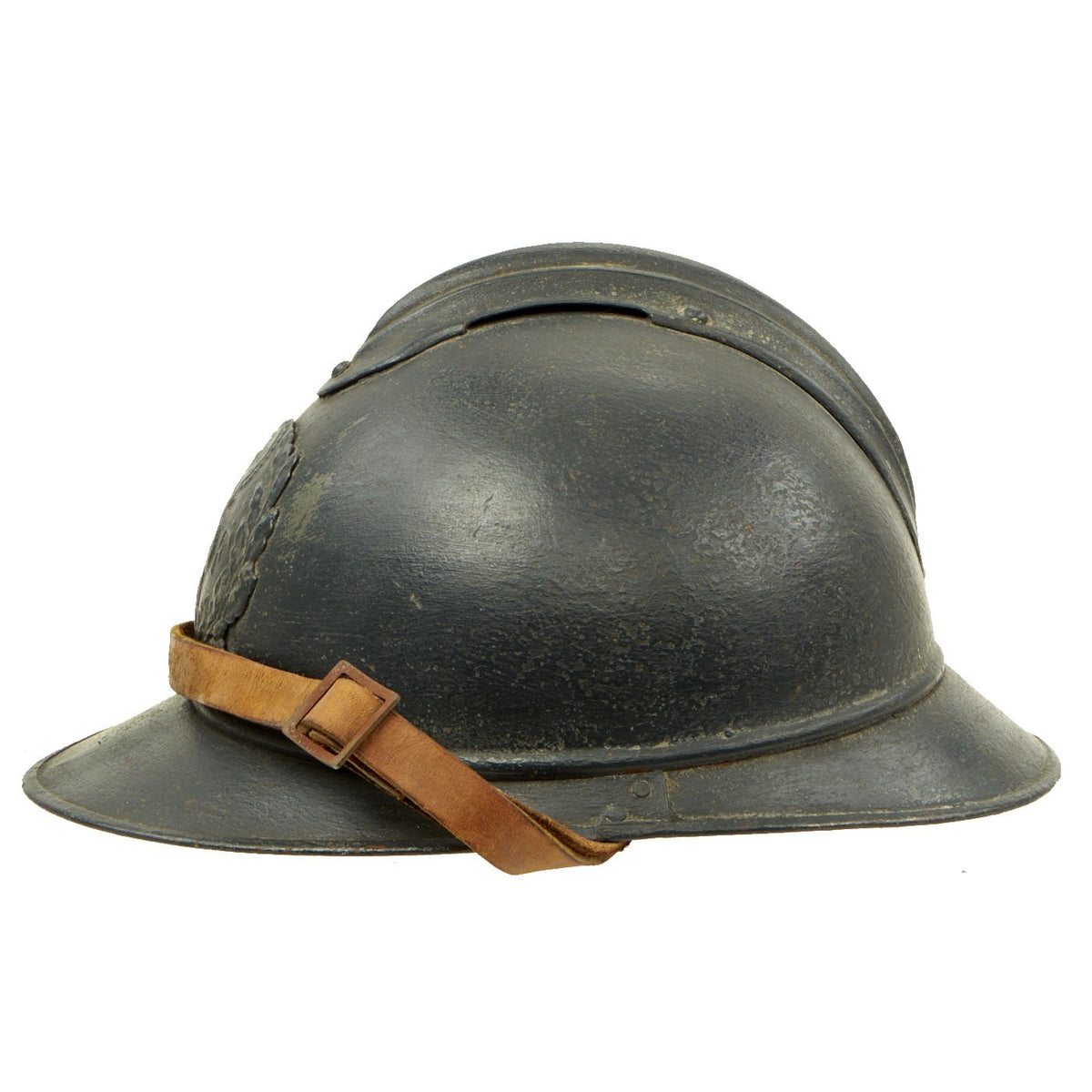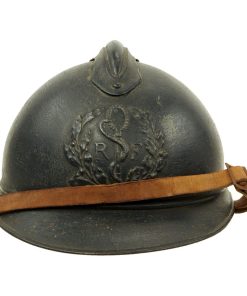Original French WWI Model 1915 Adrian Helmet with RF Field Medical Personnel Badge – Horizon Blue Original Items
$ 595,00 $ 178,50
Original Item: Only One Available. This is a very nice example of a genuine World War I M1915 French Army “Adrian” steel helmet, outfitted for medical personnel. The helmet retains the original “dark horizon blue” paint on the shell, with a few areas of wear and rust where the paint has chipped. The front of the helmet still has its original French Medical Personnel badge, which has a half Laurel / Half Oak wreath, with the medical “Rod of Asclepius” in the center. Around this is the standard R F on the “bomb”, for Republique Francaise. This is the badge used for Field Medics, Combat Surgeons, and other medical personnel operating in the field.
The liner is a nice medium size at 56cm (7-1/8), and is fair condition. There are a few small holes and tears in the liner due to its usage and age. The rear stitching on the liner has come undone, but is still present. The corrugated aluminum ventilation strips have been removed and are not present with this helmet. French soldiers would remove these aluminum strips in order to achieve a better on their heads. The top tie strap is not present, and the original brown leather chin strap is intact and in great shape with minor rust on the buckle.
Overall condition of the helmet is nice, though it does show its age. The shell shows some minor dings, scratches and paint wear consistent with age and long service. If you were looking for a nice Adrian Medic Helmet to fill out your WWI collection, this is a great chance!
The M15 Adrian helmet (French: Casque Adrian) was a combat helmet issued to the French Army during World War I. It was the first standard helmet of the French Army and was designed when millions of French troops were engaged in trench warfare, and head wounds from the falling shrapnel generated by the new technique of indirect fire became a frequent cause of battlefield casualties. Introduced in 1915, it was the first modern steel helmet and it served as the basic helmet of many armies well into the 1930s. Initially issued to infantry soldiers, in modified form they were also issued to cavalry and tank crews. A subsequent version, the M26, was used during World War II.
The French Military Medical Service (FMMS) is one of the oldest formal military medical organizations in the world. 1 The importance of preserving the fighting strength was the impetus for establishing a permanent Army Medical Corps. Napoleon I said at the beginning of the 19th century, “a restored injured [soldier] is better than ten raw recruits.” The reform of the French Army by Louvois and Letellier during the reignofLouis XIV led to the Edict of January 17, 1708, which created the French Army Medical Corps. During the same period, Colbert and Seignelay were organizing hospitals for the Navy. During the French Revolution, the Valde-Grace abbey was transformed into a military hospital
The Convention published two important acts for the French Army Medical Corps: one establishing the primacy of the medical authority over the administrative authority, and the other designating the caduceus as the symbol of the Medical Corps. Full independence of the Military Medical Corps from the Commissariat was completed in 1889. After the defeat of France during the Franco-Prussian War in 1870, the Imperial Military Medical Academy of Strasbourg, founded in 1856, was transferred to Lyon in 1888. The Navy Medical Academy was established in Bordeaux in 1889. Until 1948, the military medical corps was divided into three independent corps: Army, Navy, and Air Force. On January 1, 1948, the three corps were placed under the authority of a single Surgeon General but remained independent in their respective missions. In 1962, this authority was designated the Direction Centrale du Service de Sante des Armees, Unification of the military medical corps continued with the merging of the two military medical academies in 1970. The current configuration of the FMMC was finalized in April 1974.
Fast Shipping with Professional Packaging
Thanks to our longstanding association with UPS FedEx DHL, and other major international carriers, we are able to provide a range of shipping options. Our warehouse staff is expertly trained and will wrap your products according to our exact and precise specifications. Prior to shipping, your goods will be thoroughly examined and securely secured. We ship to thousands clients each day across multiple countries. This shows how we're dedicated to be the largest retailer on the internet. Warehouses and distribution centres can be located throughout Europe as well as the USA.
Note: Orders with more than one item will be assigned a processing date depending on the item.
Before shipping before shipping, we'll conduct a thorough inspection of the items you have ordered. Today, the majority of orders will be delivered within 48 hours. The delivery time will be between 3-7 days.
Returns
The stock is dynamic and we cannot completely manage it because multiple stakeholders are involved, including our factory and warehouse. So the actual stock may alter at any time. It's possible that you may not receive your order once the order has been made.
Our policy is valid for a period of 30 days. If you don't receive the product within 30 days, we are not able to issue a refund or an exchange.
You can only return an item if it is unused and in the same state as the day you received it. You must have the item in its original packaging.
Related products
Uncategorized
Uncategorized
Uncategorized
Australian WWII Owen MK1 Machine Carbine SMG Custom Fabricated Replica with Sling Original Items
Uncategorized
Uncategorized
Uncategorized
Uncategorized
Uncategorized
Uncategorized
Uncategorized
Uncategorized
Uncategorized
Uncategorized
Uncategorized
Angolan Rebel 1970s era 60mm Inert Display Mortar from Angolan Civil War Original Items
Uncategorized
Uncategorized
Uncategorized
Uncategorized













































































